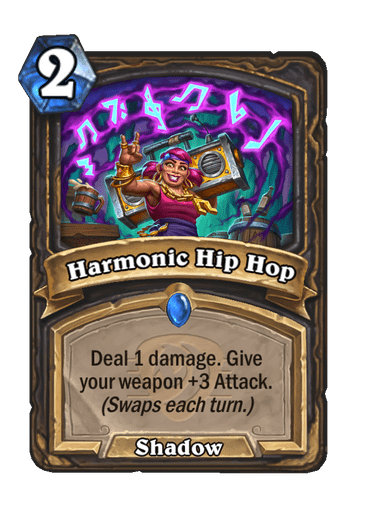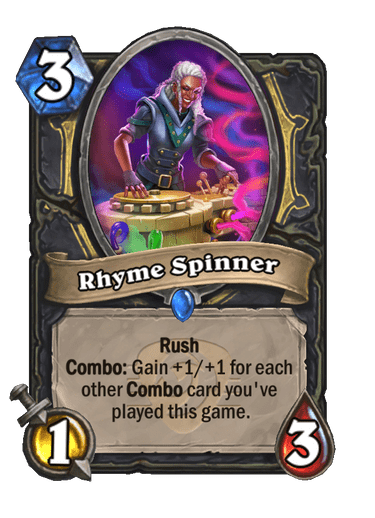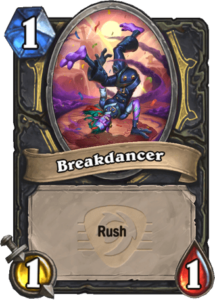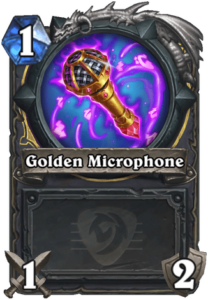
Mixtape

Your opponent tends to play good cards, since they’re playing a constructed deck, but these cards have no synergy with your deck. The only reason to play Mixtape is if you’re piloting Thief Rogue, and this archetype is losing a lot of important cards in rotation. Still, a 1-mana discover spell with a narrow and high quality pool of cards is okay. It’s not going to make or break Thief Rogue over the next year.
Score: 2
Disc Jockey

Disc Jockey is a glue card for a Rogue archetype utilizing a big combo package, which is what this set is going for. The stats are specifically geared to synergize with Breakdance. It’s a reasonable target for Shadowstep if you’re looking for a way to quickly ramp up your combo card count for Record Scratcher or Rhyme Spinner.
As a standalone card, Jockey has no chance of seeing play. It’s a 2-drop you can’t play on turn 2 without a 0-mana enabler. The stats are terrible since it dies to any damage from your opponent. The random pool of combo cards isn’t of a high enough quality and many of these cards don’t synergize with your deck unless it’s specifically built for it. It either sees play in one deck or doesn’t see play at all.
Score: 2
Mic Drop

Arcane Intellect with a bonus Deadly Poison on Finale. This is a decent draw engine for a weapon deck, such as Pirate Rogue running Swordfish. You’d run a relatively low curve to make sure you can connect the buff easily past turn 3 and the draw supports that low curve.
Other Rogue decks are unlikely to utilize this. A turn 2 dagger into a turn 3 Mic Drop might have been good in 2015, but if Rogue faces an aggressive deck and expects to live after passing 2-3 turns and using its health as a resource to clear the opponent’s minions, it’s going to find itself half dead by turn 4. This card is aggressive in nature and needs to be played by a deck that’s postured to pressure life totals with a big weapon.
Score: 2
Harmonic Hip Hop

This is the other “Weapon Rogue” support card of the set. The first version of the card is bigger Deadly Poison, equivalent to a Tinker’s Sharpsword Oil, alongside a damage ping. That’s a strong buff for a weapon with 3+ charges. The second version shrinks the buff to +1 but gives you a Dark Bomb. You’ll likely try to avoid playing the second version as it scales poorly with a weapon, unless the damage helps you clear a critical opponent minion or helps you find lethal later in the game.
Overall, this card is okay for a weapon deck. Alongside Mic Drop, there’s a bit of support for a Rogue deck that just equips a big stick and smacks the opponent in the head with it, but these cards don’t see play anywhere else since their benefits with a simple dagger are highly questionable.
Score: 2
Beatboxer

Beatboxer can be a source of damage and board control for a Combo-focused Rogue deck. As a 4/3, it has stats that make it a decent target for Breakdance, while also being cheap enough to Shadowstep. The card is obviously completely unplayable without activating its combo ability, which is worth around 1 mana (slightly better Arcane Missiles).
Again, it’s a struggle seeing this card being played by more than one deck. A plain old Miracle Rogue doesn’t need more damage sources, as it’s already been consistently skipping on premium ones (Wicked Stab). An aggressive deck that curves out will struggle to consistently activate it. A slower and more grindy deck doesn’t care about an unreliable damage source.
Score: 2
Rhyme Spinner

This is the biggest combo payoff of this set. Spinner scales with every combo card you’ve played this game, so it can theoretically become a massive target for Breakdance in the late game and produce a huge and threatening board swing. But we must look at the baseline stats of Spinner. For it to be a decent “vanilla” card, you must play at least 3 combo cards to produce a 4/6 rush for 3 mana. At that point, it becomes a reasonable enough play, but realistically this isn’t good enough to be a payoff. The standards are high for Rogue, and it needs to be better.
So, Spinner needs a large enough package of combo cards to support it. You can’t halfheartedly run it alongside 4 combo cards in the deck and expect it to do well. Those combo cards should also be comprised of minions that you can bounce and replay, furthering the combo count. The good news is that Spinner counts itself, but unless you fully commit to it, it’s probably not worth running.
Score: 2
Breakdance


Lots of players will compare this card to Shadowstep, but they are quite different. Shadowstep targets strong battlecry/combo effects over stats. Breakdance looks for strong stats rather than powerful battlecry/combo effects. Team 5 have attempted to provide minions that can specifically act as targets for both spells in this set.
But many other minions aren’t good Breakdance targets, which is why a plain Miracle Rogue list wouldn’t consider this card. The deck utilizes minions that are ideal Shadowstep targets but don’t have the stats to make Breakdance a strong enough card. The fact you’re bouncing a minion without a discount means you’re losing board initiative, so Breakdance’s stats output needs to make up for it.
If Miracle Rogue chooses to utilize a combo package with the kind of minions that offer good Breakdance targets, such as Rhyme Spinner, then Breakdance makes it. Otherwise, it’s a pass.
Score: 2
Record Scratcher

This weapon, much like Rhyme Spinner, emphasizes the need for a big combo package. Scratcher is a terrible weapon at its baseline. A 3 mana 2/2 weapon doesn’t impact the board very well. There are 2-attack weapons that cost 2 mana and see no play. But, this can help you cheat a lot of mana if you execute a big turn in which a lot of combo cards are chained together. This can help accelerate Rhyme Spinner to be a big threat at an early stage of the game and supports the utilization of Sinstone Graveyard in the deck.
However, this card directly clashes with Draka. You just can’t play Scratcher and Draka in the same deck. The big mana-cheating turn needs to be enabled by the 2nd Scratcher swing, which means that even if you end the turn on Draka, you can’t attack with the big weapon on the same turn. That gives the opponent an extra turn on your clock, so it shouldn’t be worth it. You could spend 2 mana on a hero power to break Scratcher and saving the swing for the Draka weapon, but you’re jumping through hoops at this point.
This is a tough sell. If Miracle Rogue finds out that Draka just isn’t as good without Mailbox Dancers, it may opt to run Scratcher; but if Draka remains an important win condition, it’s hard to sell Record Scratcher.
Score: 2
Bounce Around (ft. Garona)

This card has been getting so much hype, but it is flashier than it will ever be useful. So much outroar, so much noise, over a 3-mana scuffed Potion of Illusion.
Remember Potion of Illusion? For 4 mana, you could make 1/1 copies of all friendly minions on the board. Those 1 mana copies were permanent. The card has seen sporadic play in some degenerate Mage decks but has never seen any serious play in Rogue decks. Some players attempted to run it, but it was always consistently awful.
Bounce Around costs 1 less mana, but instead of making permanent 1/1 copies of your minions, it bounces your entire board back to your hand and reduces the minions’ cost to 1 mana for just this one turn. If you don’t replay these minions on the same turn you play Bounce Around, they go back to their original cost and you just lose their board presence.
So, when it comes to setting up a crazy combo that everyone imagines will destroy the format, this is worse than Potion of Illusion. Illusion might cost 1 more mana, but it’s infinitely better as a combo enabler since it gives you a full setup turn. It is not a legendary spell you can only run one copy of either, making the consistency of any combo plan involving Bounce Around exponentially more questionable.
If Bounce Around is not an amazing combo enabler, then it needs to be useful as an AOE Shadowstep effect. Shadowstep is a 0-mana card at its baseline, so you better get insane value off a 3-mana AOE version of it. This requires you to have a board of multiple battlecry/combo minions to take advantage of and replay on the same turn. If you have that big of a board lead as a Rogue, you’re already running away with the game. If you don’t have minions in play, Bounce Around becomes exceedingly difficult to utilize, even with Preparation. On one minion, this is a very expensive and bodiless Tenwu.
Outside of some game breaking combo’s that no one has thought of because they likely don’t exist, Bounce Around is completely unplayable.
Score: 1
MC Blingtron



You can think of Blingtron as a damage setup card. If you have multiple minions in play and play Blingtron, you’re amplifying their damage over two turns. This also works with off board damage, giving you +1 damage for anything that hits the opponent’s face. However, both applications have serious flaws.
The main problem is that Blingtron costs 5 mana. For an early game strategy, that’s going to be the slowest card in the deck. For a late game strategy, this is also extremely slow and requires a full turn to set up realistically. A Blingtron/Astalor dream sounds farfetched. You’re not running this card to hit your opponent for 2 with your microphone, that’s for sure.
Blingtron also clashes with weapons. If you’re running a Swordfish in your Pirate Rogue, then this card becomes awkward to use alongside your cornerstone weapon. This can be considered a weapon destroyer, but that makes it a very expensive Ooze. Furthermore, if your opponent equips a weapon in response to your Blingtron, you lose the benefit of the microphone. It’s just hard to get behind this legendary.
Score: 1
Final Thoughts
Festival of Legends Set Rank: 11th
Overall Power Ranking: 4th
Miracle Rogue’s current success is masking issues in a class that might be receiving the weakest set in Festival of Legends. While other classes look to improve or reinvent themselves, we cannot say there’s a single “transformative” card in Rogue’s set, one that excites us about a new possible strategy.
The set is dedicated almost entirely to a combo package that theoretically fits in a revised Miracle Rogue, but to get the most out of it, some sacrifices may have to be made and the payoff is not clearly better. This is a turning point in the future of the archetype.
Most of Miracle Rogue’s build survives rotation, which leads to an assumption that the deck is destined to continue its success. But one key and subtle loss is Mailbox Dancer. Following multiple nerfs to the archetype, Miracle Rogue managed to thrive through the power of Necrolord Draka, which offered a serious threat in late game matchups despite its own previous nerf to 5 mana. Draka is largely fueled by Mailbox Dancer turns and without it, there are doubts on whether Rogue can execute the kind of turns that enable Draka to be such a powerful finisher.
If Miracle Rogue manages to adjust through finding a different enabler, then the deck should continue to be a top meta contender. But if Draka ends up being significantly weakened, Miracle Rogue will hit shaky ground. It will have to roll the dice on some kind of combo package. Should this combo package end up underwhelming too, then the deck is not going to hit anywhere near the same heights it did during March of the Lich King.
Why is Miracle Rogue’s success so paramount to the success of the class? Because things look much grimmer elsewhere. Thief Rogue is losing most of its late game prowess and there are doubts on whether it can even come close to being playable. Mixtape and Hipster are very unlikely to be enough. We haven’t seen Pirate Rogue compete since early in Sunken City. Although the weapon buffs in this set could revive the archetype, the deck is very one-dimensional. Then you have the secret package with Hanar, but Hanar can no longer discover Paladin secrets, making its chains less powerful. We don’t think that a dedicated ‘Secret Rogue’ has legs to be its own deck.
So, Rogue players should hope that Miracle Rogue is strong, but not too strong to the point it gets nerfed, because there’s a wasteland of mediocrity behind it.

thank you for the information